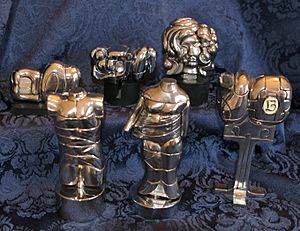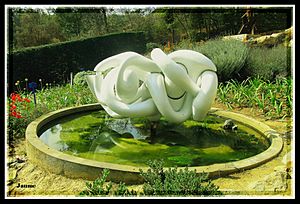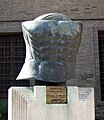Miguel Ortiz Berrocal facts for kids
Quick facts for kids
Miguel Ortiz Berrocal
|
|
|---|---|
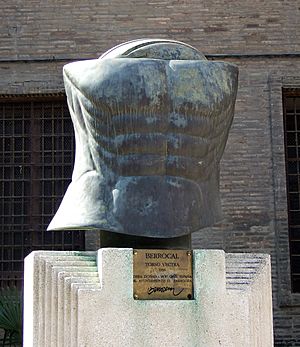
Torso Vectra (1996), at Opel España in Zaragoza, Spain
|
|
| Born | September 28, 1933 Villanueva de Algaidas, Málaga
|
| Died | May 31, 2006 (aged 72) Antequera, Málaga
|
| Nationality | Spanish |
| Known for | Puzzle sculptures |
| Style | Figurative, abstract |
Miguel Ortiz Berrocal (born September 28, 1933, in Villanueva de Algaidas, Málaga, Spain – died May 31, 2006, in Antequera, Málaga) was a Spanish sculptor. He created both realistic and abstract art.
He is most famous for his "puzzle sculptures." These artworks can be taken apart into many different pieces. What's cool is that some of them even hide tiny artworks or jewelry inside! You can also put some of his sculptures back together in different ways. Berrocal made sculptures of all sizes, from huge outdoor pieces to tiny ones you could wear as jewelry.
From 1967 to 2004, Berrocal lived and worked in Verona, Italy, and a nearby town called Negrar. He worked closely with foundries (places where metal is melted and shaped) to create his art. His work was shown all over Europe, and also in North and South America, and Japan. In 2004, he moved back to his hometown in Spain. He kept making art until he passed away suddenly in 2006. Today, the Berrocal Sculpture Foundation works to keep his art and legacy alive from its base in Villanueva de Algaidas.
Contents
About Miguel Berrocal
Early Life and Learning
From a young age, Miguel Berrocal showed a special talent for art and discovery. He would make his own toys from recycled materials. He also drew and painted using colors he mixed himself. He finished his schooling in Madrid. A very important experience for him was visiting the Prado art museum, which he went back to many times.
He studied at several art schools, including the Academia de Bellas Artes de San Fernando. He also took evening classes where he became friends with his teacher, the sculptor Ángel Ferrant. Berrocal even studied math to prepare for architecture school. He loved analytic geometry, which is a type of math that later influenced his sculptures.
Starting as an Artist
In 1952, Berrocal had his first art show in Madrid. He showed drawings of people and places from his hometown and Madrid. He signed these early works with his family name, "Ortiz." He then received a special award that allowed him to study in Italy. He lived in Rome for several months, where he saw an exhibition of Picasso's work. At that time, Picasso's art was not allowed to be shown in Spain.
In 1954, he returned to Spain for military service. After that, he went back to his studies and art classes. His friend Ferrant encouraged him to continue his work. He was invited to show his drawings at a big art event in Venice, Italy. He still signed these works "Ortiz."
In 1955, Berrocal traveled to Paris, France. He continued to paint and often met with other famous sculptors like Alberto Giacometti. He then returned to Rome, where he worked with architects. He even helped design a building facade, creating a clever system of eight parts that could be arranged in many different ways. This made each part of the building look unique.
In 1957, he showed his first sculptures, made from wrought iron, in Rome. He then decided to focus only on sculpture. He made works that explored the idea of empty and full spaces. He also thought about how a single sculpture could be seen in many different ways.
After deciding to be a sculptor, Berrocal had a studio built near Paris. He had an important first sculpture show in Milan, Italy. For this show, he started signing his work "Berrocal." A well-known art dealer, Bruno Lorenzelli, became his first supporter. During this time, he created sculptures like Torso Benamejí and Torso Her.
The year 1962 was very busy for Berrocal. He had shows in New York with other sculptors. An art dealer named Albert Loeb began to represent him in the United States. He also had his first solo show in Paris. Berrocal was known for making sure his sculptures looked different in each exhibition.
Finding a Foundry
On his way to an art show in Venice, Berrocal stopped in Verona, Italy. He was looking for a small foundry that could cast his sculptures. He found one, and together, they helped make Verona a very important place for modern art in Europe. Besides his own work, Berrocal brought many famous sculptors to Verona. These included Joan Miró, Salvador Dalí, and Magritte.
He started trying out new art methods and materials. Because of his science background, he used advanced technologies from industry in his art. In 1963, he began making many copies of his sculpture María de la O.
In 1964, Berrocal showed his sculptures at the Venice art event again. A collector bought his sculpture Mercedes. A film about his work, called Torch and Torso, was shown at the Museum of Modern Art in New York City. It won many awards. While in New York, he learned about a new way to cast metal called the Shaw process. He brought this method to Italy. It made casting bronze much cheaper and faster, while still keeping high quality. He also taught about art materials in Hamburg, Germany.
To find even better foundries, he traveled between Paris and Verona every week. In 1967, he decided to move to Verona for good. Later, he moved to Negrar, where he lived until 2004. His sculptures became more and more complex. He explored a "fourth dimension" in his art, especially in small works like Adamo Secundus and David. These small sculptures could be taken apart in many ways. In the United States, his sculptures became known as "conversation pieces" because they were so interesting to talk about.
In 1968, the French Minister of Culture honored Berrocal with a special award. German TV made a documentary about him. He met famous artist Henry Moore at an exhibition in Brussels. He also started a successful series of exhibitions in galleries in cities like Frankfurt, Geneva, and New York. This year, he made Romeo e Giulietta using a special technique that allowed him to create 2000 copies. He used similar methods for Goliath (80 pieces) and Richelieu (61 pieces). He also worked on a book that was also an art object. Important works from this time include Sainte Agathe II and Cleopatra. He also started a series of five "mini-sculptures," making 10,000 copies of each using industrial methods. His sculptures were shown in Spain for the first time.
The 1970s
In 1971, Berrocal met Maria Cristina Blais of Saxe-Coburg and Gotha Braganza. They married a few years later and had two sons, Carlos Miguel and Beltrán José.
In 1972, the city of Málaga asked him to create a large monument to honor Picasso. In 1976, this monument, called Monumento a Picasso, was shown in Paris before being placed permanently in Málaga.
In 1973, Berrocal represented Spain at a big art show in Brazil and won a major award. He visited Brazil, Peru, and Venezuela, and had an exhibition in Caracas. Based on his experience with the Picasso monument, he started a new series of very large sculptures. These included Richelieu Big and Almudena. He also created Il Cofanetto, which honored Romeo and Juliet and the city of Verona.
He started painting again, creating many colorful works. These paintings often showed themes from his sculptures, like torsos and figures. He also found old anvils, which inspired a series of sculptures called Desperta Ferro. He worked with an architect on a huge sculpture project for the border between France and Spain, but it was never built.
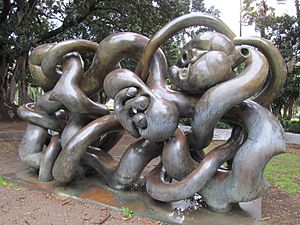
Other works from this time include La Maja and Manolete. His sculpture Torero was part of an exhibition for blind people. Thousands of people touched it to experience the art. Berrocal visited the United States. A special art space dedicated to his work opened in Paris.
By 1979, the art world was very interested in his sculptures. Berrocal received many invitations but chose to focus on his work, which became even more varied. He created works like Caballo Casinaide and Omaggio ad Arcimboldo.
The 1980s
In 1980, Berrocal had more exhibitions in Caracas and Venice. He was the only artist invited to a special meeting in Brussels about sculptures that are made in multiple copies. He finished Astronauta, a sculpture that included 21 different pieces of jewelry. It was a tribute to the writer Jules Verne.
In 1981, Berrocal started using color again in his art. He made paintings and prints. He had an exhibition in New York, where he met Andy Warhol, who painted his portrait. For Picasso’s 100th birthday, Berrocal made a medal and a plaque for Picasso’s birthplace, which had become a museum. He also made Hoplita, a sculpture that included a Rubik’s cube, as a tribute to the Hungarian mathematician who invented it.
In 1982, he had his first exhibition in Kuwait. He created the Desperta Ferro series, which included ten pieces. He also completed Neon, a sculpture with computer-controlled neon lights that could create endless combinations of horse figures. He started working with an architect on a design for a public square in Paris. He visited New York and met the mayor, Ed Koch, who was interested in placing Berrocal's sculptures in the city.
In 1984, the Spanish Ministry of Culture held a huge exhibition of his work in Madrid. A detailed book about his art was published. After Madrid, the exhibition traveled to Barcelona and Brussels. Also in 1984, people in his hometown of Algaidas created a group to start a museum for him. After 25 years, Berrocal returned to his birthplace.
The mid-1980s saw many of his large sculptures placed in public spaces. These included Sarabande pour Picasso in Paris, a fountain project in Málaga, and Torso Es for the Olympic Sculpture Park in Seoul. A major book about his work was published in French. He had his first exhibition at the museum in Villanueva de Algaidas. He also designed the sets and costumes for the opera Carmen in Verona.
The 1990s

In 1991, Berrocal was asked to create three huge sculptures for Spain's big celebrations in 1992. These events included the World's Fair in Seville, the Barcelona Olympics, and Madrid being named the Cultural Capital of Europe. For these events, he made Doña Elvira, a 6-meter-high sculpture for Seville; Manolona, a 14-meter-high sculpture for Madrid; and Citius, Altius, Fortius, a 4-meter-high torso. This last sculpture was shown in Seville before moving to its permanent home at the Olympic Museum in Lausanne in 1993.
He was also named a Goodwill Ambassador for UNESCO. When making his giant sculptures, Berrocal faced technical challenges. He researched new materials and techniques, even using advanced industrial technologies. For example, his three monumental works from this period were made using Kevlar and carbon fibre. Using these materials for art showed how deeply art, science, and technology were connected in Berrocal's work.
In 1994, he unveiled Torso de Luces in Seville. This sculpture was made for an electricity company to celebrate its 100th anniversary. Later that year, an exhibition of his multiple sculptures was held in Slovenia.
In 1995, Berrocal introduced the Fuente de la Paz (Fountain of Peace) in Ibiza. An exhibition of his sculptures and drawings was held in Verona, Italy.
From June to September 1996, Berrocal had an exhibition in Bardolino, Italy. He also installed three large sculptures in public places: Pepita in Bordeaux, France; Alcudia in Valencia, Spain; and Marcelisa in a sculpture park in Denmark.
Between 1997 and 1998, Berrocal participated in several exhibitions, including one at the Olympic Museum in Lausanne called "Small sculptures, great sculptors."
In 1999, he was at the ARCO art fair in Madrid. He also had a large solo exhibition in Madrid, which then traveled to Oviedo and Málaga. Berrocal illustrated a book for the City Council of Madrid. In September, he showed his 3-meter-high work El Diestro at an international sculpture exhibition in Venice. He also had solo exhibitions in Paris and Verona.
The 2000s
In 2000, Berrocal participated in art fairs in Miami and Madrid. He was also involved in laying the foundation stone for the Berrocal Museum in his hometown. He gave talks at universities in Spain.
He took part in group exhibitions in Hamburg and Como, and other international shows. These included the "Golden Imagination" exhibit in Italy and a solo show called "Return to Classicism: The Fusion of Art and Science" in Villanueva de Algaidas.
In 2002, he was part of group exhibitions in Verona and Vicenza. He also participated in a traveling exhibition about the design of the Euro currency. That summer, he prepared a large exhibition of his drawings and sculptures in Valencia, Spain. A significant book with photos and essays was published for this exhibition.
In 2003, his exhibition continued in Málaga. It featured several large sculptures, including the wooden Richelieu Big, which is two meters tall and can be taken apart into 61 pieces. He also showed his work in Milan, Belgium, Venice, Frankfurt, and Rome. A collection of his jewelry was shown in Belgium and received great reviews.
During 2004, he showed works at the ARCO art fair in Madrid. He also participated in an exhibition that combined art and science. In June, he was part of a group exhibition in Madrid. In the summer, an outdoor exhibition of his large sculptures in Costa Brava, Spain, attracted over 150,000 visitors. His work Melilla was shown for the first time there. This piece was later placed permanently in the city of Melilla.
Return to Spain
At the end of 2004, Berrocal decided to move back to Andalusia permanently. He made his home in his birthplace, Villanueva de Algaidas. There, he oversaw the building of his new studio, a huge warehouse among olive trees. This studio was meant to hold all the artworks he had created over more than 50 years.
In 2005, he wrote his life story and prepared two other books: a complete list of his sculptures and another list of his paintings, drawings, and prints.
He also joined ten other sculptors in a project near Naples, Italy. That fall, a powerful sculpture made from volcanic stone was placed on the side of Mount Vesuvius. Berrocal began moving his belongings from his old home and studio in Italy, where he had lived for forty years, to his new home in Spain.
In February 2006, he finished Large Leaning Nude, a sculpture made of white Kevlar. It now looks like a white cloud over the landscape of Lake Como. That year, he finished writing his memoirs. He continued to work on drawings and sketches for new sculptures.
Miguel Berrocal passed away on May 31, 2006, in Antequera.
What Made Berrocal's Art Special
Young Berrocal wanted to find his own artistic path. He asked himself, "How can I make people truly connect with sculpture?" This question led him to develop his unique art style, which can be understood through seven main ideas:
- Science as inspiration: Berrocal used his knowledge of science and architecture to create art. His pieces often showed how beauty can be found in math, physics, and the hidden rules of the world.
- Empty space: He went beyond traditional sculpture by exploring the spaces inside his artworks. He believed that "empty space is as alive as full space."
- Disassembly: Many of his sculptures can be taken apart. This means viewers have to assemble and disassemble them to truly understand their inner parts and hidden spaces.
- Interactive art: Because his sculptures could be taken apart, they were designed to be touched and explored with your hands. It's like drawing an image yourself, which helps you understand it more deeply.
- Techniques: Berrocal invented many new ways to create his complex sculptures. He used both clever ideas and advanced building methods to bring his visions to life.
- Multiples: His sculptures were so complex and precise that he often made many signed and numbered copies. Berrocal wanted to make sculpture available to everyone, just like prints made paintings more accessible.
- The "Project": All of Berrocal's complex sculptures started with a huge amount of planning and documents. These "projects" showed how art, science, and technology worked together in his creative process. The entire project itself was considered a work of art.
The Berrocal Foundation
To protect and share Miguel Berrocal's huge collection of art, the Berrocal Sculpture Foundation was created on November 22, 2007. This was done by his family, following his wishes. The foundation aims to preserve, research, and share his work. It also supports the growth of sculpture and the arts in general. The foundation is located in Berrocal's last studio and workshop in his hometown of Villanueva de Algaidas, Spain.
The foundation has seven ongoing programs:
- Managing art collections: Helping organize exhibitions of Berrocal's works and those of other artists connected to him.
- Publications: Creating books and other materials about Miguel Berrocal's art and life.
- Conservation: Keeping track of, organizing, and preserving Berrocal's artworks.
- Archives and documentation: Organizing and preserving all of Berrocal's notes, drawings, and other documents.
- Art production: Continuing to make limited editions of Berrocal's sculptures.
- Studio-Workshop: Preserving and showing Berrocal's workshop in Spain. They also hold educational workshops there.
- Berrocal Museum: Working to create a museum dedicated to Berrocal in Villanueva de Algaidas.
Berrocal Creative Universe
The Berrocal Creative Universe is a group of three places that showcase the sculptor's work. It opened in 2013. The Museum shows his paintings and prints. The Studio-Workshop lets visitors see how complex his creative process was and how he made his sculptures that could be taken apart. The House-Museum gives visitors a sense of Berrocal's personality and displays art by his many artist friends.
Museum
The Berrocal Museum building is still being developed. Its first part, open to the public, is the Center of Interpretation of Water and Contemporary Art. It has an exhibition about the artist's large fountains. This show helps visitors understand how an artist uses the beauty and complexity of water in different ways. The museum also displays some of the sculptor's lesser-known drawings and prints. These works show his strong connection to his homeland and the landscapes of Villanueva de Algaidas. As a young artist, he started as a painter, finding inspiration in the olive groves, the faces of people, and the light of this ancient land.
Studio-Workshop
Visitors can see a selection of Berrocal's sculptures, especially his early works. They can also see his mechanical workshop, where he created prototypes and finished his sculptures. His personal studio shows his process of research, study, calculations, and drawing. The studio also holds Berrocal's personal library, with over 5000 books, and a collection of his limited edition sculptures.
Famous Works
- Opus 8 Balaustradas (1955-57)
- Opus 28 La Boîte découpée (1959)
- Opus 31 Grand torse (1959)
- Opus 38 Torso her (1961)
- Opus 60 Mercedes (1962)
- Opus 92 Maria de la O (1962-64)
- Opus 101 Romeo et Giulietta (1966-67)
- Opus 107 Mini David (1967)
- Opus 114 Goliath (1968-72)
- Opus 115 Richelieu (1968-73)
- Opus 129 Monumento a Picasso (1972-74)
- Opus 130 Almudena (1974)
- Opus 397 Manolona (1991-92)
- Opus 444 Adriano Big (1994)
Images for kids
See also
 In Spanish: Miguel Ortiz Berrocal para niños
In Spanish: Miguel Ortiz Berrocal para niños


